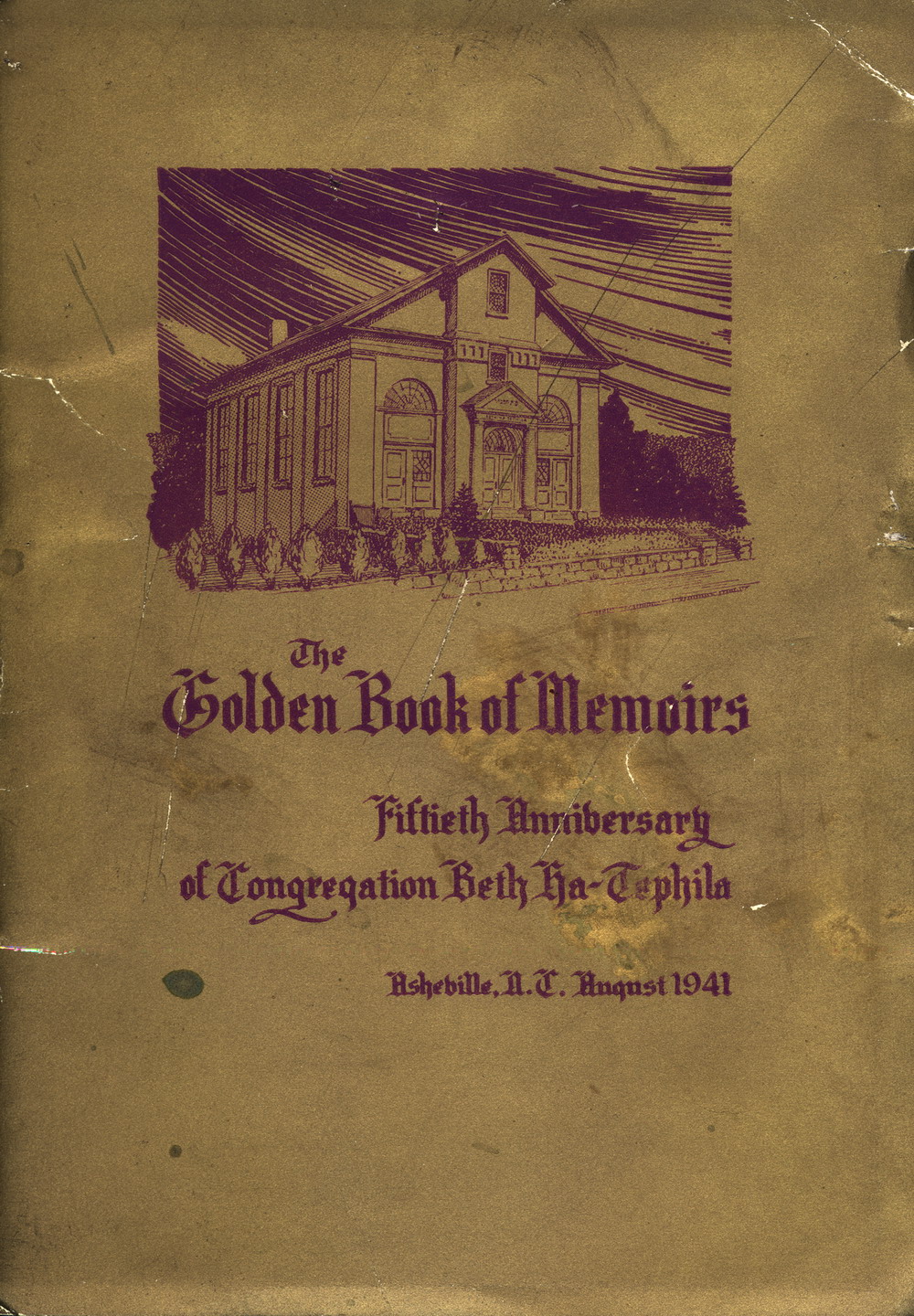|
Contents |
| Page Number |
Item Number |
Description |
Thumbnail |
| Cover |
gbom_cover |
The Golden Book of Memoirs
Fiftieth Anniversary of Congregation Beth Ha-Tephila
Asheville, N.C. August 1941 |
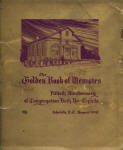 |
| Page 1 |
gbom_001 |
THE Golden Book of Memoirs
IS GRATEFULLY DEDICATED TO THE
PIONEERS OF 1891
THEY FOUNDED A CONGREGATION
through which men complete their lives
in communion with God,
in fraternity with men,
in love of children,
in dreams for a better world.
THEY ESTABLISHED A SOCIETY
by which men voice their loyalty to their people
and further God's work through the
advancement of Judaism here
and throughout the world. |
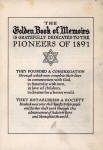 |
| Page 2 |
gbom_002 |
TEMPLE CHARTER MEMBERS
L. Blomberg came to Asheville from Aiken, S. C., in 1887. For many years he was in business in "The Racket Store," with his brother.
Mr. Blomberg recalls that many Temple meetings were held in his home on Woodfin Street. He was for many years a generous contributor
to the Temple, and active on the cemetery committee "in the old days." His children, Harry, Nat, Sigmund, Edna and Frieda, have loyally worked
for the welfare of the Temple.
In 1887 Morris Meyers came to Asheville. For forty years he was in business on Biltmore Avenue in "The Palais Royal." He also practiced law several years.
His first wife was Miss Sarah Ellick, half-sister of Solomon Lipinsky. After her death he married Miss Belle Fortune. Mr. Meyers has been a civic
and social club leader, having been the first president of the Elks' Lodge, the Eagles, and an active member of many other societies. For a long time
he was a generous contributor to the congregation. He remembers the actual meeting in old Lyceum Hall, when he signed his name as charter member.
[image captions: L. BLOMBERG
MORRIS MEYERS] |
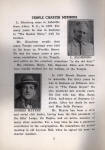 |
| Page 3 |
gbom_003 |
OFFICERS AND RABBI
MAX H. CROHN
President | LEO FINKELSTEIN
Vice-President |
ROBERT P. JACOBS
Rabbi |
JOSEPH R. STERNBERG
Secretary | GUSTAV LICHTENFELS
Treasurer |
|
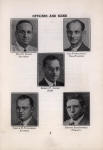 |
| Page 4 |
gbom_004 |
TEMPLE OFFICERS
| Max H. Crohn, President |
| Leo Finkelstein, Vice-President |
| Joseph R. Sternberg, Secretary |
| Gustav Lichtenfels, Treasurer |
| J.B. Breman | Isaac Gradman |
| Joseph M. Cooper | Harold Goldbloom |
| Joseph Dave | Mrs. Mortimer I. Kahn |
| Dr. Leon H. Feldman | Dr. Samuel Robinson |
| Mrs. G. Lichtenfels, President |
| Mrs. Samuel Robinson, First Vice-President |
| Mrs. Joseph Sternberg, Second Vice-President |
| Mrs. Sol Isaacs, Corresponding Secretary |
| Mrs. Coleman Zageir, Recording Secretary |
| Mrs. Max Reisenberg, Treasurer |
| Julius Lowenbein, President |
| Isaac Gradman, Vice-President |
| Harold Goldbloom, Secretary and Treasurer |
| Leo Finkelstein, General Chairman |
| Mrs. Joseph R. Sternberg, Sisterhood Representative |
| Isaac Gradman, Brotherhood Representative |
| Max H. Crohn | Rabbi Robert P. Jacobs |
| Dr. Leon H. Feldman | Gustav Lichtenfels |
| Harold Goldbloom | Joseph R. Sternberg |
|
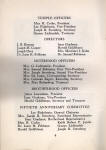 |
| Page 5 |
gbom_005 |
PAST PRESIDENTS OF OUR CONGREGATION
| Abraham Whitlock | Gustav Lichtenfels |
| Solomon Lipinsky | Marcus Sterne, Jr. |
| Siegfried Sternberg | L. H. Pollock |
| Julius Lowenbein | J. B. Breman |
| Morris Lipinsky |
| Mrs. S. Whit Lees | Mrs. M. I. Kahn |
| Mrs. Roy E. Swartzberg | Mrs. Max H. Crohn |
| Mrs. Marcus Sterne, Jr. | Mrs. B. A. Pollock |
| Mrs. S. H. Rogovin | Mrs. Sallie Eisenberg |
| Mrs. L. H. Pollock | Mrs. Samuel Robinson |
| Mrs. J. B. Breman |
| Dr. Samuel Robinson | Gustav Lichtenfels |
| J. B. Breman | Tippie Galumbeck |
| Marcus Sterne, Jr. | Max H. Crohn |
| Joseph Dave | Leon Finkelstein |
| Joseph M. Cooper | Dr. Leon H. Feldman |
| J. A. Patla |
|
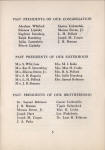 |
| Page 6 |
gbom_006 |
THE MESSAGE OF THE PRESIDENT
WHEN I realize that twelve years before I was born, a group of far-seeing Jews created Congregation Beth Ha-Tephila, I am thrilled to the fullness of my heart.
It was a distinct honor to be elected to the presidency over a year ago and to be re-elected was a generous gesture on the part of the members. If my term of office
is a success, it is through the untiring efforts of my brother officers and directors; the energy and religious counseling of Rabbi Jacobs; and the spirited
co-operation of you, the members of the congregation. I extend my cordial greetings and thanks to the visiting rabbis who so kindly consented to participate in this
happy celebration. To those contributors who made our Golden Book of Memoirs possible, I extend my grateful thanks. My constant prayer is that God will bestow upon
me the same wisdom, ability, religious sensibility and esteem of my fellow worshipers as those presiding officers of years gone by were endowed with. May we continue
for many years to come the noble work the first twenty-seven men started 50 years ago. May our House of Prayer be forever a true Sanctuary of Religion and the center
of Jewish culture, to which our children and their descendants can turn for solace, hope and renewed courage.
Sincerely yours,
MAX H. CROHN. |
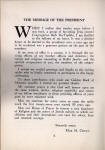 |
| Page 7 |
gbom_007 |
THE FIFTIETH ANNIVERSARY MESSAGE OF THE RABBI
Dear Friends:
IN the last 50 years, Asheville Jewry enacted on its small stage what was happening on the gigantic stage of the whole country. In a word, it was this: "Newcomers"
came in, generation after generation, and brought their own Jewish emphases from local European backgrounds. Thus, in one generation, a "Reform" group dominated;
in another, an "Orthodox." As each group sank roots into the community, and children were born and became "Ashevillian" in accent of speech and in habit of behavior
and thinking, the Temple reflected this Americanization.
You will see this clearly in the congregation's story told in this book. Within our membership is an
amalgamation of "Reform" and "Orthodox," with the emphasis definitely on Reform Judaism. But the see-saw history of this congregation, like that of every other in the
country, shows a fascinating picture of change. The "Reform" group in our congregation has lost its early rigidity, and the "Orthodox" group in our congregation has lost
its scrupulous observance of the minutiae of Jewish law. The two behavior-patterns have mellowed and blended.
This is a new and wonderful moment in our congregation's
history. Within our Temple, an American type of Judaism is a-borning. It is not yet here. We are in transition. Today, all we need for a safe and successful voyage
is a continuation of your Jewish loyalty, as well as a strong faith and readiness to see it through. |
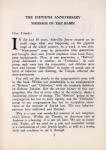 |
| Page 8 |
gbom_008 |
I am delighted to be the rabbi of the congregation at this time, for it is a time of amazing change, wonderful growth and great development.
It is a time of challenge; and those conscious of what is happening will enjoy living and working out the destiny of the Temple in Asheville. As elsewhere, most people
will go through this time without recognizing it for what it is. But the thinking and participating and laboring elements within our ranks—they have a wonderful
and rewarding task. They will go forward. Our young, enthusiastic president, his loyal officers and hard-working and sacrificing Board of Directors—a group of trustworthy
and exceptionally capable friends—they are your leaders and "lawgivers." I am proud to be associated with them. They will do their job if you will uphold their hands.
Our program of activity, our projects for the coming years, are based upon the assumption that you are for us and with us every minute of the time.
As your rabbi,
I congratulate you, the members of Congregation Beth Ha-Taphila. You are as fine a group of Jews as one can find anywhere in the country. From you will come a great future, dedicated
to the advancement of Judaism, the happiness of your children, and the strengthening of a great and splendid congregation in Israel.
Sincerely yours,
ROBERT P. JACOBS. |
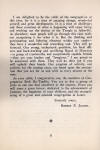 |
| Page 9 |
gbom_009 |
To the Members, Officers and Rabbi of Beth Ha-Taphila Congregation, Asheville, North Carolina.
I CAN not too warmly congratulate Beth Ha-Tephila
Congregation on its half-century consistent and distinguished representation and wise furtherance of the cause of liberal Judaism in its providentially assigned territory.
The sacrifices of but a meagre band of devoted Jews enabled the congregation to come into existence and it has been and is the example and the spirit of that pioneering
few that has kept and is keeping the congregation sacrificially existent to this day. Because of its character the congregation has attained an influence far out of
proportion to its small membership. It is the peak Jewish congregation of the Carolinas, not merely in geographical situation but eminently so in religious leadership.
It has stressed Jewry as being distinctively a religious entity. With this emphasis it has ever cordially cultivated an intimate fellowship with all the spiritual
factors in its sphere of activity. With the orthodox Jewish congregations of the city and vicinity it has forever main- |
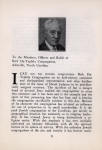 |
| Page 10 |
gbom_010 |
tained a relation of affectionate co-operativeness. With all the congregations of our Christian brethren it has constantly worked together in all
concerns of charity, social uplift and patriotic activity and its ministers and theirs have frequently exchanged pulpits in Sabbath worship. While there have been differences
and debate in its councils there has never been dissension. The intelligence of its membership forever required of its rabbis, not leadership, but simply official spokesmanship
and foremost representativeness.
My ministerial service with the congregation was twelve years of blessed privilege and unqualified happiness and it is indeed a pride
to me that I am still permitted to retain connection with it as its rabbi emeritus.
In these congratulations and expressions my wife most heartily joins me.
MOSES P. JACOBSON.
Los Angeles, Calif. July 19, 1941. |
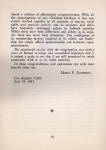 |
| Page 11 |
gbom_011 |
A HISTORY OF CONGREGATION BETH HA-TEPHILA
FIFTY years have passed since that day, August 16, 1891, when twenty-seven men founded Congregation Beth Ha-Tephila. The two-score years and ten are filled with thrilling,
creative, turbulent episodes, stories of men and women of strong convictions speaking their minds and hearts with eloquence and vigor. There are tales of vigorous
personalities who bestride the pages of our records. Joy and sorrow commingle, success and failure blend, as the memory of things past comes into our ken.
Greater than they knew was the accomplishment of those men who sat around a table in old Lyceum Hall on South Main Street (now Biltmore avenue) and took up the tasks their
forefathers had begun. Their courage, their hope, their love of Judaism loom up significantly today as their contribution to all the generations that followed. We are grateful.
At the very beginning, they were not sure of hteir ground. Asheville was a little mountain community, with wide, muddy streets. The roads into town were the narrow mountain
roads, twisting in tortuous turns for mile on mile, worn down by countless generations of Indians and pioneers. The one-story buildings lined the streets. The hillfolk, gathering
at corners for snatches of conversation, gazed curiously at the few Jews in their midst. The mountaineers of Western North Carolina were from England, Scotland, Wales and Ireland,
completely Anglo-Saxon. For the most part they were kindly, but the handful of Jews wondered . . .
But there were the children to think of; there was their own pressing need for fellowship of the right kind. And |
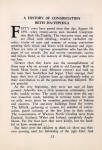 |
| Page 12 |
gbom_012 |
on August 16, 1891, they gathered together. They elected Abraham Whitlock as pro-tem president, Solomon Lipinsky as
pro-tem treasurer, and G. H. Mayer as pro-tem secretary.
One of those present was not satisfied. E. Sternberger rose to his feet and said:
"I move that this be a permanent organization." It was a memorable moment when they voted. For then and there, history was made. They took
unto themselves the age-old Jewish responsibility for the care and education of their children, the establishment of a house of worship and
the conduct of services, and the creation of a meeting-place for good fellowship. We today look back through the years, and we think of that
"permanent organization" which they founded. "Except the Lord build the house, they labor in vain who build it."
Who were the men and women
who left a permanent impress upon all the pages of our history? There was Solomon Lipinsky, vigorous, slow-talking but eloquent, suave, the
founder of a great department store, influential among rich and poor. There was Siegfried Sternberg, a volatile personality, roubust and aggressive,
yet kindly, a benefactor to untold numbers of Jews and Gentiles alike. There was Sir Philip S. Henry, the cultured English Jew, ever-ready to
offer of his largess. There was Mrs. Minnie Loryea Barnett, attentive to the needs of the congregation, unfalteringly loyal and generous.
And Mrs. M. D. Long, gracious, magnetic, poised, a personality with every attractive quality and with a sense of responsibility to the community.
Other names throng upon us—S. H. Friedman, G. Alexander, Charles Rutenberg, Jacob Cohen, A. Kreslowsky, Ralph Rosenberg, M. D. Long.
There were the rabbis: Lazaron, Zeisler, Barasch, Wessel, Rhine, Jacobson, and Kline. Each name conjures up pictures of a pulpiteer, a friend,
a confidant. How their names bring us back through the kaleidescopic years! |
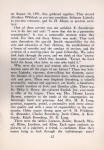 |
| Page 13 |
gbom_013 |
Friendly talks . . . special meals when the rabbi was guest . . . funerals of beloved ones . . . weddings of
youngsters . . . Bar-Mitzvohs ... Confirmations.
And now, fifty years after! In each heart and mind is a different story of those fifty
years, a tale of which we can tell only a part.
A WEEK after that first memorable meeting, a constitution and by-laws were
ready. The men gathered together in Lyceum Hall on August 23, 1891. E. Sternberger was elected vice-president. The constitution and by-laws
were adopted. Read the first article: "This organization shall be known as the Congregation Beth Ha-Tephila (The House of Prayer) and shall
be conservative ..." And the second article: "This organization is formed for the purpose of holding religious services, establishing a Sunday
School, purchasing a cemetery, acquiring a house of worship, or any other purpose within the scope of Judaism." Twenty-seven men signed their
names as charter members.
Today, we honor their memory and dedicate this book to them, the Pioneers of 1891:
| M. Marks | E. Straus |
| Max Lindau | M. Meyers |
| Louis Marks | Max Marcus |
| S. J. Lindau | A. L. Solomon |
| B. Swartzberg |
| Morris N. Epstien | A. Whitlock |
| L. Blomberg | G. H. Mayer |
| L. Berman | S. Lipinsky |
| Sam Finestein | M. D. Long |
| R. Jacobson | B. Zageir |
| E. Sternberger | M. Shuman |
| B. Whitlock | J. Cohen |
|
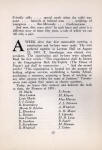 |
| Page 14 |
gbom_014 |
| M. Swartzberg | S. Schiffman |
| A. Blomberg | A. B. Schayer |
Were you to look over those old "minutes of the meetings,"
some curious facts would come to light. Dues were $10 a year, payable quarterly. When one was six months in arrears, he was suspended and could
be reinstated only upon payment of all back dues and a majority vote for the congregation. The treasurer was bonded for $500, although his report
never showed more than $165 in the bank at a single time.
The first "minister" was Reverend A. Jacoby from Charleston, W. Va., to serve during
the Holy Days of 1891. Mr. A. B. Schayer, himself a charter member of the congregation, was also engaged to assist him, "both men not to cost over
$150" as set forth in the budget.
Lyceum Hall was the first "home" of the congregation. They used it for everything: worship, Sunday School and
social affairs. It was rented from a fraternal order at the rate of $75 per year. Here G. H. Mayer, the secretary, served also as the first superintendent
of the Sunday School. We haven't the record, but he probably taught the children from "The Catechism," a Sunday School popular in those days.
When Purim came that first year, a successful party was held by the young men of the congregation. It netted $52.30, and they gave it to the congregation
with the recommendation that it be used to buy an organ, "the same to be the property of the congregation." The new organ aroused them to further efforts.
They formed a choir "to improve the services," and in order to avoid expense from the music they used the traditional melodies.
The first annual election, held in 1892, saw Mr. Whit- |
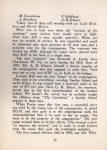 |
| Page 15 |
gbom_015 |
lock retained in the presidency, M. D. Long as vice-president, and Mr. Schayer elected "reader" at a salary of $100 payable
after the Holy Days. Toward the end of that year, Jacob Cohen replaced G. H. Mayer as secretary and also as superintendent of the Sunday School.
Apparently, the two positions went together.
On November 25, 1892, Congregation Beth Ha-Tephila was duly chartered by registration in the office
of the Clerk of Superior Court for Buncombe County, North Carolina. The charter was taken out to enable them to purchase land for cemetery use.
But then the arguments began! Where was the best place? Chunns Cove or a section in Riverside Cemetery? Chunns Cove cost $250, Riverside cost $500.
Finally, convenience decided the issue. Riverside it was, one acre. But now came another question. Who would take care of the deceased? What about
the Burial Society (Chevra Kadisha) ? Was it a part of the congregation or a separate organization? At first, the decision was to form a separate
society. It was a long time before that "society" became a cemetery committee of the congregation. Mr. Kreslowsky, the father of Mrs. A. Whitlock,
was in charge of the cemetery.
Another important question about the "reader" had to be decided. Should he wear a cap and robe, or not ?
The minutes of February 3, 1893 give the answer. Mr. Schayer was permitted to buy a cap and a robe.
THE next ten years of the congregation's life are unknown. No written records are available. Perhaps the initial force had spent tiself.
Perhaps it was the depression of the 90's. Whatever it was, the congregation was not too weak to weather the first cruical period.
And new forces were now at work. Newly arriving families found the congregation insuffici- |
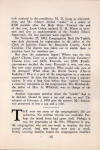 |
| Page 16 |
gbom_016 |
ently orthodox. But Abraham Whitlock, the president, and Solomon Lipinsky, energetic young merchant, were emphatic in
their emphasis upon Reform Judaism. As a result, the small Jewish community was split into two congregations, orthodox and reform. Neither seemed
to make much headway.
Three men served successively as secretaries of the congregation, Jacob Cohen, Bernard Whitlock and Solomon Lipinsky.
There was no regular Sabbath service. The Sunday School was loosely organized and attendance was irregular. Such synagogue activities as there were,
were held at Odd Fellows Hall in the Hilliard Building on Biltmore avenue (opposite Eagle street). When the lodge moved to the third floor of a
building on Church strteet, the congregation moved with them. That is where we find them at the turn of the century.
IN April, 1902, a rare opportunity presented itself to the congregation. The present Temple edifice was available. It had been used as a
Baptist Church since 1863, and sold to the Christian Church in 1891. In 1900, the trustees of that congregation deeded the building to their
minister, the Reverend T. M. Meyers, in lieu of the salary due him as minister. The Reverend Mr. Meyers had been forced to borrow on the
property, and was glad to find a buyer in Congregation Beth Ha-Tephlia. The purchase price was $2000.
It gave the congregation a new lease
on life. Through the efforts of Mrs. M. D. Long, the ladies of the congregation formed an auxiliary, known as The Jewish Ladies' Aid Society,
to help pay for the edifice. "The Aid" did its work efficiently. In later years it brought forth new purposes: the care of the cemetery,
the making of shrouds, and visiting the sick. |
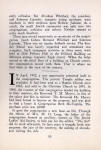 |
| Page 17 |
gbom_017 |
Shortly after the purchase of the building, there came to Asheville a wealthy and cultured English Jew, Sir Philip S. Henry.
He established his "Zealandia" estate on Beaucatcher mountain. His interest was aroused in the struggling congregation, and he offered to help.
Several hundred dollars went toward improving the building. There were a bell tower and a spire that made it a church-like structure. They were removed.
On February 8, 1908, the congregation formally affiliated with the Union of American Hebrew Congregations, the federation of Reform congregations
in the country. By this time, they felt themselves to be a completely Reform organization, for in their constitution was now a clause:
"This organization shall be known as the Reformed Congregation Beth Ha-Tephilah, 'The House of Prayer,' and the Union Prayer Book shall be the official ritual used."
Who were the rabbis in those early days? There is little or no mention of them. Most of the congregational activity took place during the summer
and until after the Holy Days. During the winter, the members themselves were the "readers." Among them were Fred Cone, S. Lipinsky and Julius Lowenbein.
For a while,—in 1912—a certain Rabbi George Benedict served.
Many of the older folks will remember with great joy the services of the young student from Hebrew Union College who spent seven summers in Asheville,
from 1908 to 1914. Today, Morris S. Lazaron is one of America's outstanding rabbis, holding a pulpit of high prestige in Baltimore, Maryland. He officiated at
Friday night services, and conducted a Sunday School. His parents lived here at that time.
Officers during this period were Solomon Lipinsky,
president; Julius Lowenbein, treasurer; and Morris Lipinsky, secretary. The Jewish Ladies' Aid Society was (Continued on Page 20) |
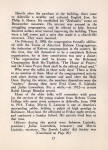 |
| Page 18 |
gbom_018 |
FIFTIETH ANNIVERSARY SABBATH SERVICE
FRIDAY, AUGUST 15, 1941
EIGHT P.M.
- Sabbath Service, Union Prayer Book—Rabbi Robert P. Jacobs
- Torah Service, Page 94—Rabbi Jacobs, assisted by Louis Blomberg and Morris Meyers, charter members of the congregation
- Solo—"By The Waters Of Babylon." By Sigmund Blomberg
- Anniversary Program:
Greetings............................Max H. Crohn President of the Congregation
Greetings............................Rev. W. G. McFarland Pres. of Asheville Ministerial Association
Introduction of Speaker
Anniversary Sermon.......Rabbi Wm. F. Rosenblum Temple Israel of the City of New York
- Solo—"How Beautiful Upon The Mountains." By Miss Elda Vettori
- Concluding Service
- Closing Hymn
- Announcements
- Benediction and Recessional
(Following the services, a reception in honor of Rabbi Rosenblum will be held at the Jewish Community Center on Charlotte Street. All are cordially invited.)
(Rabbi Morris S. Lazaron, of Baltimore, Md., beloved friend of many Ashevillians, may be with us on this occasion.) |
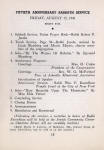 |
| Page 19 |
gbom_019 |
FIFTIETH ANNIVERSARY BANQUET PROGRAM
MONDAY, AUGUST 18, 1941 — 8:00 P.M.
At The Grove Park Inn
Mr. Leo Finkelstein
General Chairman and Toastmaster
Addresses of Welcome....
President of the Congregation Mr. Max H. Crohn
President of the SisterhoodMrs. Gustav Lichtenfels
President of the Temple ClubMr. Julius Lowenbein
Musical Numbers—Miss Ella Vettori and Mr. Sigmund Blomberg, accompanied by Miss Blanche Loftain.
Recognition of Living Charter Members.
Messages of Greeting:
Hon. James E. Divelbiss
Vice-Mayor of the City of Asheville
Rev. R. F. Campbell
Minister Emeritus, First Presbyterian Church
Rabbi David Wachtfogel
Rabbi, Bikur Cholim Congregation
Mr. D. Hiden Ramsey
General Manager, The "Citizen-Times" Company
Response to Greetings..................Rabbi Robert P. Jacobs
Duet......By Miss Ella Vettori and Mr. Sigmund Blomberg
Introduction of Past Presidents of Congregation, Sisterhood and Temple Club
Anniversary Address:
"Time and Eternity In The Life Of A Congregation" Rev. Dr. James G. Heller
The Isaac M. Wise Temple of Cincinnati, Ohio, Pres. of Central Conference of American Rabbis |
 |
| Page 20 | gbom_020 |
(Continued from Page 17)
active, for the minutes contain frequent references to it. At one time they contributed
$34.25 to the "furnace fund." The congregation numbered about twenty-five.
In 1915, Mr. Miskend, a student at Hebrew Union College, officiated at the High Holy Days.
Officers that year were S. Lipinsky, president; G. Alexander, vice-president; Charles Rutenberg, treasurer; and Morris Lipinsky, secretary.
That was the year the Ladies' Aid pressed for a permanent rabbi for the congregation. A Rabbi Zeisler was, indeed, engaged. But it was a great
strain to maintain him properly. He stayed only a few months. For the Holy Days, a Mr. Margolis officiated. The following year, 1917, a Mr. Meyerowitz
officiated so well that a special gift was awarded him. When, that year, Morris Lipinsky moved to Wilmington, Gustav Alexander succeeded him as secretary.
MEANWHILE, new Jewish families were moving into the city. Among them was Seigfried Sternberg, a vigorous and determined personality whose influence was immediately felt.
Throughout his life he used his splendid energies to establish a strong and active synagogue in Asheville. He never wavered in his loyalty and generosity to the Temple as
the center of Jewish life and in his generosity to it. In August, 1917, Siegfried Sternberg became the president of the congregation. After the Holy Days, new life pulsated
through the membership. Members came in. Many a summer visitor supported the congregation generously.
Among them was Mrs. Minnie Loryea Barnett, a summer visitor
from Manning, S. C. Mrs. Barnett wrote the congregation of her own accord, and offered $100 annually toward the maintenance of a permanent rabbi. The im- |
 |
| Page 21 | gbom_021 |
pulse of this kindly woman pervaded the congregation, and in March, 1918, Rabbi Nathan Barasch was elected. Not quite a year later, he resigned to become a chaplain in the army.
Although woman suffrage had not yet become a national issue, the constitution of the congregation had been holding membership open to women. The first to join was
Mrs. Jennie Kroman on June 23rd, 1918. She was a loyal member until her death in 1930.
During Rabbi Barasch's short term, the congregation was surcharged with conflicting emotions.
It was the old debate all over again, Reform or "Conservative?" Which should it be? S. H. Friedman, a strong booster for synagogue vitality, active since his election to the Board of Directors
in August, 1917, now came forward with an amendment to the constitution. Its purpose was to change the congregation into the "conservative" type.
The meeting of March 16, 1919,
was a memorable one. The president's gavel fell frequently that day to restore order. For determined men spoke their minds, pleading for high principles, and stirring their listeners with
appeals for a vital Judaism that would strike resounding chords in the hearts of their children for generations to come. They rose to their feet quickly to challenge an
opposing idea. This was the democratic way to settle an issue.
Solomon Lipinsky held their attention for over an hour that day. He pleaded for a recognition of the necessities
of the new day. This was an American generation. Only Reform Judaism could meet the challenge and retain Jewish loyalties. Not even his opponent, Mr. Friedman, could fail to recognize the man's complete
and moving sincerity. Nor could he match his eloquence. The die was cast. When the vote was taken, only six votes were in favor of the amendment. The crisis had been weathered.
Proudly we acknowledge the high calibre of the men |
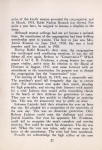 |
| Page 22 | gbom_022 |
of that day. In many another community, this was sufficient cause for the minority to secede and to form another congregation. But they recognized that if democracy was to
work, the will of the majority must rule. There was vitality amongst the leadership, and a readiness to serve. When, during the commotion of that year, Gustav Alexander withdrew from the secretaryship,
another man came forward and was elected. He was Dr. Samuel Robinson, a young optician.
In the summer of 1919, Rabbi A. B. Rhine of Hot Springs, Arkansas, came to Asheville
for an extended visit. He conducted Sabbath worship, and, together with Mrs. Rhine, carried on a successful Sunday School. The congregation was grateful for their ministrations.
But by now, the need for a permanent leader was pressing. It came to a head almost immediately. For the Holy Days, the congregation employed a senior student from Hebrew
Union College, Mr. Harvey Wessel. So thoroughly did he stir the hearts of the people that Fall day, that the pulpit was offered him at an initial salary of $3.000 per year, pending his graduation from school. Rabbi Wessel took charge in July, 1920. The following year, he was re-elected at a salary of $3,600 per year.
Officers at that time were Ralph Rosenberg, president; S. Whit Lees, vice-president; S. Robinson, secretary; and Charles Rutenberg, treasurer.
In 1922, S. Lipinsky was
returned to the presidency, which office he held until his death in 1925.
When Rabbi Wessel resigned in 1922, he was instrumental in bringing to Asheville the outstanding
rabbinical personality of the congregation's history: Dr. Moses P. Jacobson, a pioneer Reform rabbi. When the Holy Days services of that year were over, the congregation
knew that it had "found" its rabbi. They voted him a year's |
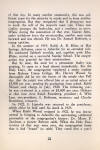 |
| Page 23 | gbom_023 |
contract at $4,000 per annum. Dr. Jacobson had outstanding qualities that endeared him to Jews and Gentiles alike. His leadership was inspirational and purposeful.
Through his encouragement and through the efforts of Mrs. Jacobson, the Sisterhood was formed in 1922 as a permanent auxiliary of the congregation. Its first officers were
Mrs. S. Whit Lees, president, and Mrs. S. Robinson, secretary. During its first year, the women bought a large organ for the Temple, and an automobile for the rabbi's personal use.
Mrs. Lees set a high standard for all future presidents. The congregation is everlastingly grateful for her inspired leadership.
A NEW spirit of vitality gripped the members. They were in the building mood. For twenty years they had worshipped in the tottering building. It was time to erect a sanctuary
of which they could be proud, and which would demonstrate in no uncertain terms the religious spirit of the American Jew. Siegfried Sternberg felt the impulse generated by Dr. Jacobson.
Together with Dr. S. Robinson, the secretary of the congregation for many years, Mr. Sternberg made the down-payment on a spacious lot on Merrimon Avenue. Their hearts beat fast
as they thought of the day when they would present the project to the others. It must go through. Julius Lowenbein was called into their confidence and he lent further
enthusiastic assistance. Everything was arranged for the memorable meeting of April 1, 1924. The congregation and the Sisterhood met together. To understand what followed, we munt
see two factors at work in the congregation. Two men were its acknowledged leaders, Siegfried Sternberg, impulsive but always ready to support his words with monetary gifts, and Solomon |
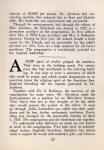 |
| Page 24 | gbom_024 |
Lipinsky, then in his 69th year and in his last illness which finally claimed him the following year. Around each man had grown up a coterie of loyal supporters.
Although both were on friendliest terms, they were of different temperaments. The second factor was the disturbing fact that for all of Solomon Lipinsky's energetic attempt to
"get out of the crowd" on Friday night and Saturday morning services, they were poorly attended. It rankled within him.
When Siegfried Sternberg stood before the
meeting and in excited accents explained that the groundwork had already been laid for the movement for a new Temple, his listeners' hearts beat quickly. Had the time truly come?
Then Solomon Lipinsky came forward. How different were his slow, sure words that were moving and eloquent, and persuasive. This movement, he said, was "premature." Perhaps the
time would someday be at hand. But this was not the time. Look at your attendance at services, he reminded them. "First fill to overflowing this Temple, before you consider building a new one."
It was a telling phrase. It pricked the bubble of enthusiasm, and Siegfried Sternberg's excited words no longer reached their mark. The golden moment had passed.
The minutes of that meeting close with the ominous phrase, "No action taken."
For years afterwards, there was grumbling and murmuring. People called the old building "that barn," and other epithets.
But it did no good. The boom days passed. The depression set in. Men's foreheads were furrowed with lines of worry. They had personal problems. A new Temple could wait. It did. |
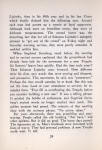 |
| Page 25 | gbom_025 |
IT was a new era, beginning with 1925. Two of the congregation's beloved members passed away, Solomon Lipinsky in March, and Mrs. Minnie Loryea Barnett, early in May.
All Asheville honored the former, for he was a respected citizen, a merchant prince, a dynamic personality, a reverent and active Jew. Mrs. Barnett, ever thoughtful,
left $5,000 as an endowment, a fund which, throueh the hectic years that followed, has deteriorated to less than a fourth.
In that year, Siegfried Sternberg was president,
Max Taub, treasurer, and Nathan Friedman, secretary. The membership, during all the 20's, varied from 70 to 95, and the budget, from $6000 to $7500. A choir was maintained,
and both Friday night and Saturday morning services were held.
In June, 1926, a great honor came to Asheville. Through the influence of Dr. Jacobson, the organization
of Reform Rabbis, the Central Conference of American Rabbis, held their annual meeting here, in Kenilworth Inn, commanding a superb view of the surrounding hills and peaks.
It was a memorable event in the history of the congregation. Many of the members attended every session open to the public, and heard the country's outstanding rabbis discuss
some of the weightiest problems of the day.
The 1927 officers were Julius Lowenbein, president, Morris Lipinsky, treasurer, and Max Polansky, secretary. The following year,
Dr. Jacobson's contract was renewed for a second five years.
Through the efforts of Siegfried Sternberg, title was obtained to three acres of land adjoining the congregation's cemetery.
The price was $3,000. Under the expert direction of Gustav Lichtenfels, this new section has recently been completely landscaped and beautified, and now presents |
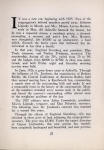 |
| Page 26 | gbom_026 |
a lovely park-like appearance, a cemetery of which any congregation might well be proud.
In July, 1927, Mrs. M. D. Long passed away.
In her will she bequeathed $3500 to the congregation, $2500 of which was to be used for the building of a new Temple. The following year, the Sisterhood used $2,500
of the fund and matched it with a similar amount of their own. They purchased a house on Montford avenue, to be used as the "Temple Center" and as a stepping stone to a new Timple.
For over five years it was the center of social and cultural life in the city. During the depths of the depression, the property was foreclosed; and for the second time the dream
of a new Temple faded away.
The 1928 officers were S. Sternberg, president; S. Robinson, vice-president; Ed Goldsmith, secretary; and Morris Lipinsky, treasurer. In 1929, Morris
Lipinsky was president, G. Lichtenfels, vice-president; Roye Swartzberg, treasurer. In 1930: G. Lichtenfels, president; S. Robinson, vice-president; Ed Goldsmith, secretary, and Roye Swartzberg, treasurer.
In April, 1930, Dr. Jacobson went with J. A. Patla and Dr. S. Robinson to a convention of the Union of American Hebrew Congregations at Atlanta, Georgia. As a result of the inspiration of their trip,
the three organized the men of the congregation into a brotherhood, called "Temple Club," which afterwards became affiliated with the National Federation of Temple Brotherhoods.
Dr. S. Robinson, at whose home the organization meeting was held in the middle of May, 1930, was its first president. Temple Club has flourished as a medium of cultural and social intercourse among the men.
In the Fall of 1930, the depression struck Asheville. Banks closed. Many Jews were heavily involved and some bankruptcies ensured. Dr. Jacobson voluntarily cut his salary |
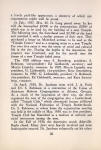 |
| Page 27 | gbom_027 |
to $2400. Despite his heroic efforts, congregational affairs slumped. The membership dropped to 54.
In the 1932 election, Joseph Dave became the new secretary of the congregation.
On October 3, 1932, at the Temple Center on Montford avenue, Temple Club honored Dr. Jacobson on his tenth anniversary with the congregation. Joseph M. Cooper, Louis Lipinsky and Gustav Lichtenfels took part in the program.
Confirmation ceremonies on May 30, 1933, were memorable. Two records were set. Nineteen confirmands received certificates. More than 300 people filled the auditorium of the Temple, and scores were turned away.
In August, 1933, Dr. Jacobson's contract was renewed for another year. But by the following Spring, it was apparent that the congregation could not bear up under the mounting deficit. Dr. Jacobson announced that he would retire at the termination of his contract on September 1, 1934. It looked for a while as though the Temple would be closed.
But Rabbi Louis I. Egelson, of the Union of American Hebrew Congregations, came to Asheville. He appealed to the congregation to keep the Temple open, offering to furnish a young, well-qualified rabbi at a small salary. The congregation agreed, and Rabbi Alexander S. Kline came to the pulpit. Dr. Jacobson was elected to the honorary position of Rabbi Emeritus.
In 1934, the officers were Marcus Sterne, Jr., president; Joseph M. Cooper, vice-president; Phil Zageir, treasurer; and Max H. Crohn, secretary. In 1935, L. H. Pollock was president, Joseph Cooper, vice-president, G. Lichtenfels, treasurer, and Max H. Crohn, secretary.
Under Rabbi Kline, interest in Temple affairs revived. He was re-elected each succeeding year, at increases in |
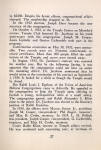 |
| Page 28 | gbom_028 |
salary. He was popular in many organizations in the city. On one occasion, Rabbi Kline turned over to the congregation a check he had received in the amount of $15.
This sum was the nucleus of a fund for the building of a new Temple, under the direction of the Building Fund committee, of which Joseph M. Cooper was chairman.
The following year the fund had grown and, with the addition of a sum from the cemetery fund, the congregation obtained, for $1750, the title to the corner property adjoining the Temple at the corner of Spruce and Woodfin streets.
In 1936, Joseph Cooper became president; J. B. Breman, vice-president; Joseph A. Patla, secretary; and G. Lichtenfels, treasurer.
The membership grew steadily until,
in August, 1937, it numbered 73. In April, 1938, Rabbi Kline notified the congregation that he would not be available after the termination of his contract on September 1, 1938.
At the annual meeting of May 30, 1938, officers elected were J. B. Breman, president; Joseph Dave, vice-president; Joseph M. Cooper, secretary; and G. Lichtenfels, treasurer. During the summer of 1938, a number of rabbis were brought to Asheville.
After considering numerous applications, the congregation finally elected Rabbi Robert P. Jacobs of Hoboken, New Jersey, a graduate of the Jewish Institute of Religion of New York City. Rabbi Jacobs began serving on September 1, 1938.
In the Fall of 1938, with the splendid cooperation of Joseph Dave, a professional choir was engaged under the guidance of Miss Blanche Loftain and Miss Elda Vettori. J. B. Breman, the president, skillfully guided the congregation and set it on the first steps toward financial security.
During 1939, Joseph Cooper withdrew as secretary, and Dr. S. Robinson served temporarily, until Louis B. |
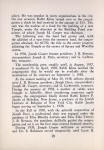 |
| Page 29 | gbom_029 |
Rifkin took charge of the books. At the end of that year, Mr. Breman took ill, and a new slate of officers came into the congregation. Max H. Crohn was president; Leo Finkelstein, vice-president; G. Lichtenfels, treasurer; and Joe R. Sternberg, secretary.
In the summer of that year, the new officers called upon Rabbi Jacob D. Schwarz, director of synagogue activities of the Union of American Hebrew Congregations, to set up a complete reorganization. He did it with consummate skill, and the congregation took a new lease on life.
SINCE 1938, the congregation has grown from 73 to 113 members, and is second in size among North Carolina's Reform congregations. Various popular innovations of Rabbi Jacobs include a Torah Service on Friday evenings, a weekly bulletin, and a new system of Sunday School and private instruction.
In 1939, six adults finished a course in Hebrew. Six children have taken Hebrew for two years in winter and summer seasons. The year-round average attendance at Temple is well over 60, and in summer months it is over 70. In 1939, Rabbi Jacobs inaugurated a weekly 30-minute radio program, entitled
"The Message of Israel," broadcast over Station WWNC. In two years, 70 programs were broadcast, and over 1000 letters and cards were received. Rabbi Jacobs conducts a course in Bible during the summer session of Asheville College. This year, several students came from Georgia and Florida,
as well as from this state, to take the Rabbi's courses. A number of students return to their homes each year and give courses in Bible to their townsfolk, based on the instruction received at Asheville College. Rabbi Jacobs has been closely identified with progressive movements in the city. He is a director of the Community |
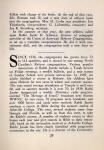 |
| Page 30 | gbom_030 |
Welfare Council, Inc., and was Director of Public Relations for the 1940 Community Chest Campaign. He is a member of the Advisory Committee of the County Child Welfare Department.
WHO are the lay-leaders of today? Our officers, Leo Finkelstein, Gustav Lichtenfels and Joe R. Sternberg are led by a young, enthusiastic president, Max H. Crohn. Leo Finkelstein is recognized throughout the city for his capabilities as an affable leader of men;
Joe R. Sternberg, an outstanding secretary, was acclaimed last year as the one responsible for the smooth functioning of the Holy Days Committee; Dr. L. H. Feldman ably directed the congregation's financial committee and showed splendid organizing ability;
Harold Goldbloom, a newcomer to our midst, whose willing endeavors have endeared him to all and to whom we look for much leadership in future years; Isaac Grad-man, already a proven leader and able worker; and many another eager young man now rising to leadership.
Many others are responsible for the fine spirit of cooperation in our ranks. There is Joseph Dave, who has been a quiet, persuasive, influential figure in all our activities. He is responsible for the splendid music in our services through the year. Generously he gives of his time and substance.
J. B. Breman works with intelligent restraint and cogency, skilfully keeping our "ship of state" on an even keel. Gustav Lichtenfels, hard-workfng treasurer, for many years chairman of the Cemetery committee, has a respected name in the community, and is an indefatigable worker for our welfare.
Dr. Samuel Robinson, a man whose unquenchable fire of religious enthusiasm and unqualified sincerity and loyalty have long made him a dependable and militant worker for Temple welfare. There |
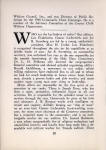 |
| Page 31 | gbom_031 |
is Joseph M. Cooper, for long filled with the dream of a new sanctuary, a "Temple-centered" thinker. And Julius Lowenbein, whom Dr. Jacobson recently described as "the finest Jew any congregation has ever been blessed with,"—Julius Lowenbein
who recently received national fame and recognition for his weekly trips to all the hospitals and sanitoria in Asheville, to greet with a cheery "hello" hundreds upon hundreds of shut-ins. For almost 40 years Mr. Lowenbein's visits have reinvigorated the spirits of the sick and the suffering.
From the time of Mrs. Jennie Kroman, the first woman-member, to this day, women have blessed us with their activity and support. Today, a host of them are active in our midst. Mrs. Gustav Lichtenfels, president of the Sisterhood, has been the "mother-Jewess" of Asheville for many years,
a worthy successor to her sainted mother; whose household has been a veritable "Jewish Community Center" in itself, Mrs. S. H. Rogovin has distinguished herself in innumerable posts of leadership, efficiently directing the Sunday School Committee; and now she presides over the Council of Jewish Women.
Her worthy successor as Sunday School Committee chairman is Mrs. Harry Blomberg, during whose term a Parent-Teachers Association was formed, giving promise of much good in years to come. Our women-leaders are numerous: Mrs. Joe R. Sternberg, Mrs. M. I. Kahn, Mrs. L. H. Pollock, and many others whose deeds have blessed and will bless us all.
WHO knows what the future will bring? President Crohn has many projects which, through hard and cooperative work, will carry us further along on the road to success. Perhaps we shall soon have a Junior Congregation, an active program of adult instruction in Hebrew, Bible and Jewish History; |
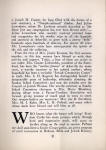 |
| Page 32 | gbom_032 |
and forums; a close collaboration, in a spirit of good will, with all Jewish organizations in our city; an active P. T. A. in our Sunday School. Eagerly we await the coming years.
DO you remember the first motion recorded in our minutes? Mr. E. Sternberg arose and said: "I move that this organization be permanent!" How shall we of this generation secure the permanency of Congregation Beth Ha-Tephila?
We must look at the functions of a congregation in Israel. A congregation provides various services. It enables members to worship as they desire. It gives them fellowship of the right. It instructs them. It inspires them.
It constantly feeds them hope and uplift of spirit. It instructs their children and their youth.
To do all these things well, we must continually look ahead and plan. Is our present Temple good enough for us?
With our present building, can we fulfill the functions of a vital congregation ? A time must soon come when we shall do something about it ...
What a miracle memory is!
It bridges the years. And today, fifty years have passed. Ought we not at this time bow down before God on high, and give praise to His Holy Name, with the ancient Hebrew blessing?
". . . . schehecheyonu, v'kiy'monu, v'higi'onu laz'man hazeh!"
". . . . Who has sustained and preserved us, and permitted us reach this blessed time!"
(This history is the result of a cooperative effort in research and editing of many hands and minds.) |
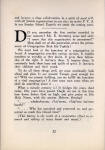 |
| Page 33 | gbom_033 |
MEMBERSHIP OF CONGREGATION BETH HA-TEPHILA
| Victor Avzaradel | Mrs. Hyman Goldstein |
| Dr. A. A. Berg | Al. J. Goodman |
| Mrs. S. Berney | Isaac Gradman |
| Harry Blomberg | Charles Grand |
| Mrs. Bluma Breen | Louis Grand |
| J. B. Breman | Mrs. Fannie Gross |
| Mrs. J. B. Breman | Leon Gross |
| Mrs. Otto Buseck | Morris Gross |
| Fred Cooley | Rudolph Gumpert |
| Joseph M. Cooper | Alfred Haas |
| Mrs. Joseph M. Cooper | Jules Heyman |
| Max H. Crohn | Mrs. David Hoffman |
| Mrs. Max H. Crohn | Sol. C. Isaac |
| Hyman Dave | Mortimer I. Kahn |
| Joseph Dave | Mrs. Mortimer I. Kahn |
| Mrs. Joseph Dave | Joseph Kartus |
| Mrs. Sallie Eisenberg | Abe Kanter |
| Miss Amy Emanuel | Ira G. Katz |
| Ed. I. Fater | A. L. Kronfield |
| Mrs. D. Fater | Leon S. Lachman |
| Dr. Leon H. Feldman | Herschel Lange |
| Sam Feldman | S. W. Lees |
| Leo Finkelstein | Mrs. S. W. Lees |
| Seymour Fligel | Alfred J. Lichtenfels |
| Mrs. S. H. Friedman | Gustav Lichtenfels |
| B. Fruhauf | Mrs. Gustav Lichtenfels |
|
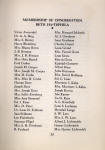 |
| Page 34 | gbom_034 |
| T. Galumbeck | Arnold Lifter |
| Mrs. Hyman Goldberg | J. S. Lieberman |
| Harold Goldbloom | Julius Levitch |
| S. R. Goldman | Mrs. A. Linn |
| Edward Goldsmith | Louis Lipinsky |
| Miss Joel Goldsmith | Morris Lipinsky |
| Morris Lipinsky, Jr. | Mrs. Harold Rosen |
| Julius Lowenbein | J. Rosen |
| Dave Marder | Martin Rosenthal |
| Frank Marder | Mrs. Frieda Rothenberg |
| Max L. Mayer | Dave Sandman |
| Miss Saidee Belle Meyers | Aaron Schandler |
| William Michalove | Max Schwartz |
| Sam Orovitz | Dr. Eugene Shapiro |
| Mrs. Annie Palais | Miss Sarah Sheffler |
| Joseph A. Patla | Mrs. Frank Silverman |
| Barney Pearlman | Joe R. Sternberg |
| P. Fred. Pearlman | Mrs. Joe R. Sternberg |
| Robert Persky | Marcus Sterne, Jr. |
| B. A. Pollock | Harry H. Straus |
| L. H. Pollock | J. Sultan |
| Mrs. L. H. Pollock | Dr. Robert Thorner |
| A. R. Rabhan | Mrs. Minnie Tureff |
| Mrs. Dora Rapport | Ben Warner |
| Dr. Max Riesenberg | Arthur Weintraub |
| Louis B. Rifkin | Samson Weiss |
| Daniel Robinson | Harry Winner |
| Dr. Samuel Robinson | Coleman Zageir |
| Mrs. Samuel Robinson |
| Miss Leah Robinson | Phil Zageir |
| Mrs. S. H. Rogovin | Robert Zageir |
|
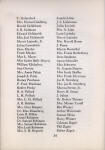 |
| Page 35 | gbom_035 |
In Grateful Appreciation For The Support Of Our Friends Whose Generous Contributions Helped Make Possible This Golden Book Of Memoirs
ASHEVILLE
| Adams-Blauvelt, Inc. | Hester Pharmacy |
| Asheville Lodge B'Nai B'Rith | R. A. Hilliard, Mgr. Reliance Life |
| Asheville Nehi Bottling Co. | H. W. Kindler |
| Halsey B. Leavitt |
| Mr. and Mrs. Harry Blomberg | Mr. and Mrs. R. J. Lewis |
| Mangel's |
| Biltmore Dairy Farms | Morris-Gearing Co. |
| Bon Marche, Inc. | McCormick Letter Service |
| John Carroll | McIntyre Bros. |
| Mr. and Mrs. Joseph Cooper | Ness Bros. & Co. |
| Mr. and Mrs. Max H. Crohn | C. I. Poor |
| Reusing Light & Refrig. Co. |
| Mr. and Mrs. Joseph Dave | William Rosenfeld, Reliance Life |
| Dunn-Groce Co. | Max Schwarz, N. Y. Life Ins. Co. |
| R. L. Ellis |
| Etta's Beauty Shop | Sherwin-Williams Co.
| | Mr. Leo Finkelstein | Southern Paper Products Co. |
| Mrs. Harry Finkselstein |
| Florida's | The Stephens Press |
| Galliher Bros. | United Tire & Retreading Co. |
| General Building Products Co. | Wachtel's |
| W. Bowen Henderson | WISE Radio Station |
|
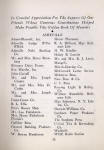 |
| Page 36 | gbom_036 |
OUT-OF-TOWN
| American Utilization Co., Bessemer City., N. C. | Marilyna Marshall, New York, N. Y. |
| Nathan Brownstein, Philadelphia, Pa. | Middletown Iron & Steel Co., Middletown, Ohio |
| Philip Chazen, Knoxville, Tenn. | Moskowitz Bros., Cincinnati, Ohio |
| Mose Duberstein, Dayton, Ohio | J. L. Rau, Albany, Ga. |
| Glant & Co., Philadelphia, Pa. | Max Roth, New York, N. Y. |
| Benj. Harris & Co., Chicago Heights, Ill. | Moses & Garrison Siskin, Chattanooga, Tenn. |
| George Kelrick, New York, N. Y. | Shaffer & Max, Allentown, Pa. |
| The D. Labold Co., Portsmouth, Ohio | Louis Sorkin, New York, N. Y. |
| Lynchburg Iron & Steel Co., Lynchburg, Va. | Jack Witten, Gastonia, N. C. |
The sketches and artistic arrangement of this booklet
are entirely the creation of
MR. BURNLEY WEAVER
The Fiftieth Anniversary Committee gratefully records this appreciation of his assistance. |
ASHEVILLE, N. C. |
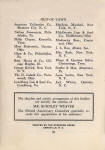 |


